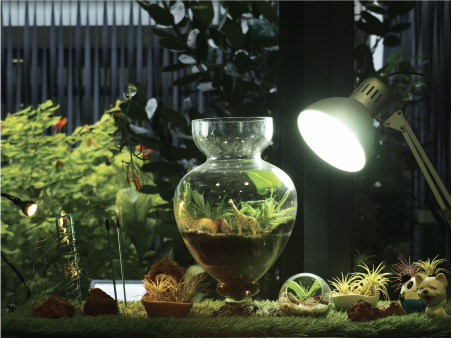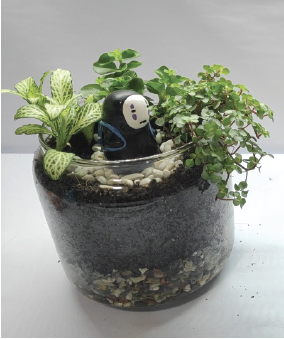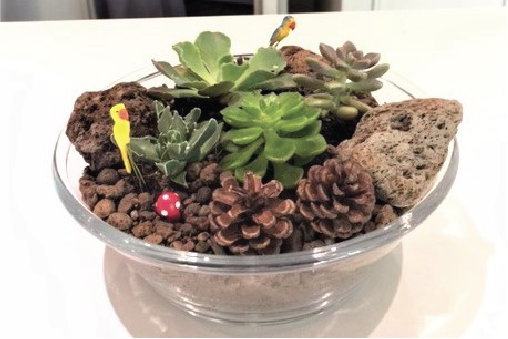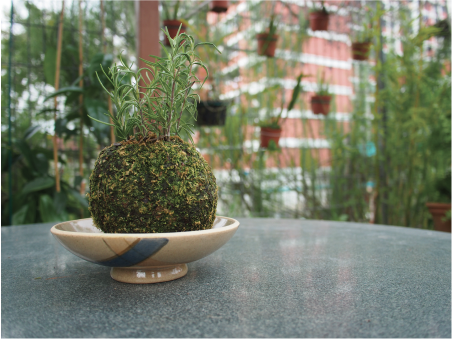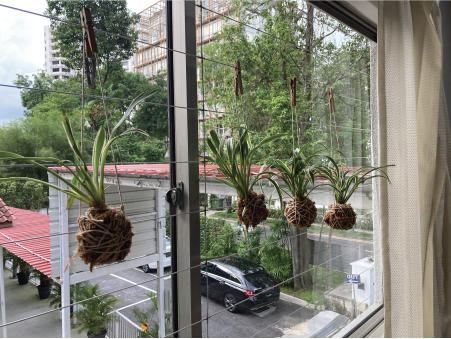Creative Ideas for Indoor Gardens

Published on
24 Jul 2022
Published by
National Parks Board
Creating an indoor garden is a great way to bring nature into our urban living spaces, allowing us to enjoy greenery in everyday living and deepen our appreciation for plants in our City in Nature.
Having an indoor garden helps to improve one’s mental and physical well-being. Besides including potted plants in your indoor garden, having an arrangement of dish gardens or a group of hanging kokedama could make your space more interesting.
For beginners, it will be good to start with one type of indoor garden before moving on to more advanced arrangements. After gaining more experience, you may also take it one step further by constructing an indoor landscape! Read on to find out what type of indoor garden appeals to you.
Terrariums
Terrariums are miniature ecosystems encased in containers which are either lidless or sealable. They are generally low-maintenance.
An open terrarium is created with a lidless container and is suitable for plants that are less able to adapt to a humid environment such as Elephant Bush (Portulaca afra) and Panda Plant (Kakanchoe tomentosa).
An open terrarium
Photo credit: Jacqueline Chua
A closed terrarium on the other hand is created with a sealable container and suitable for plants that can adapt to high humidity. The water is released by the plants through transpiration, and is circulated and returned into the soil, ready to be absorbed by the plants again. The plants to be kept in these containers should be resilient enough such that the poor ventilation does not result in the growth of fungus and mould. Some plants suitable for a closed terrarium include Nerve Plant (Fittonia albivenis), Mat spike-moss (Selaginella kraussiana) and Peperomia sp.
Dish Gardens
Dish gardens make use of dishes or shallow containers to form miniature landscape gardens. Maintenance for your dish garden depends on the type of plants in it and whether the dish has drainage holes. For dish gardens without drainage holes, a layer of gravel is recommended as the base layer to serve as a reservoir for excess water that flows from the soil layer.
A dish garden
Photo credit: Joanne Phang
Alternatively, you can also create a succulent-themed dish garden. A unique contrast to the usual foliage-heavy indoor gardens, such a dish garden is easy to maintain as it usually only needs watering about once a week, depending on where it is located. Succulents usually do better in a balcony setting or in a room by a bright window and protected from the rain. They need some air flow so that the fungus and mould do not grow on them. The succulents arranged together in a dish garden should have similar requirements for light and water. Some succulents you could consider having for your dish garden are Sea Urchin Cactus (Astrophytum asterias), Lawyer’s Tongue (Gasteria obliqua), and Walking Sanseveria (Dracaena pinguicula).
A succulent-themed dish garden
Photo credit: Joanne Phang
Kokedama
Kokedama, which literally translates to “moss ball” in Japanese, is a Japanese variant of bonsai. It is made by moulding the root ball into a circular shape with the plant sticking up from the middle. The outer parts of the root ball can be covered by sheet moss or sphagnum moss. You can also use coco fibre to wrap these balls instead of sphagnum moss as coco fibre is cheaper (also, sphagnum moss may not be as environmentally friendly).
A kokedama displayed on a bowl
Photo credit: Jacqueline Chua
Kokedamas hung by the window
Photo credit: Joanne Phang
The kokedama is then wrapped with twine and can be hung up or displayed in a bowl. The amount of light and water that the kokedama requires is dependent on the plant species. Some species that grow well as a kokedama would be Window-Leaf Monstera (Monstera obliqua), Wandering Jew (Trandescantia zebrina) or Lipstick Plant (Aeschynanthus pulcher). For example, a kokedama with Window-leaf Monstera needs more water and partial shade. Generally, the kokedama can be watered by either spraying the moss-covered portion with water regularly or soaking in water for about 30 minutes once a week.
Gardening with Edibles
The City in Nature vision seeks to bring greenery closer to all residents. The community plays a key role in the ownership and stewardship for nature which will benefit our health and well-being.
NParks is partnering residents to make Singapore our City in Nature and spark a love for community gardening through the Gardening with Edibles initiative launched in June 2020. Under this programme, some 400,000 free seed packets have been distributed to interested members of the public. Relevant resources are also available online, to guide gardeners along the way.
Also, NParks is expanding the allotment gardening scheme and the Community in Bloom programme, to welcome even more residents into the gardening family.
The Gardening with Edibles initiative is aligned with Singapore’s national strategy to strengthen our food resilience. The “30 by 30” goal, led by the Singapore Food Agency, aims to produce 30% of Singapore’s nutritional needs locally by the year 2030. The programme is jointly funded by founding partners DBS Bank and Tote Board through the Garden City Fund.
Learning More
If you are a gardening newbie, visit NParksSG, our refreshed YouTube channel that serves as a one-stop repository for close to 300 video resources. It covers topics ranging from types of soil needed for your garden and how to plant, harvest and even cook your edibles.
To learn more about growing edible plants, please watch our videos on Gardening with Edibles.
To learn more about growing edible plants safely, please download our guide on Horticultural Best Practices for Edible Gardening. For additional resources on growing edible plants, please check out our list of Gardening Resources.
For more information about the flora and fauna found in Singapore, please visit NParks Flora and Fauna Web.
If you like what you read, follow us on Facebook, Instagram and Telegram to get the latest updates.
Text by Joanne Phang
Photos by Jacqueline Chua and Joanne Phang
About the writer
Joanne Phang is a manager with the Community in Bloom (CIB) team in the Horticulture and Community Gardening Division in NParks. She guides members of the community, schools and organisations on the set-up and maintenance of their community gardens, and conducts basic gardening sharing sessions for these CIB groups to equip them with the necessary horticulture knowledge and skills.
Source: National Parks Board. Reproduced with permission.
ALL views, content, information and/or materials expressed / presented by any third party apart from Council For Third Age, belong strictly to such third party. Any such third party views, content, information and/or materials provided herein are for convenience and/or general information purposes only. Council For Third Age shall not be responsible nor liable for any injury, loss or damage whatsoever arising directly or indirectly howsoever in connection with or as a result of any person accessing or acting on any such views, content, information and/or materials. Such third party views, content, information and/or materials do not imply and shall not be construed as a representation, warranty, endorsement and/or verification by Council For Third Age in respect of such views, content, information and/or materials.
